[Page 105]Abstract: In 2013 we published a study examining names from Solomon Spalding’s fictional manuscript, J. R. R. Tolkien’s fictional works, and nineteenth-century US census records. Results showed names created by authors of fiction followed phonemic patterns that differed from those of authentic names from a variety of cultural origins found in the US census. The current study used the same methodology to compare Book of Mormon names to the three name sources in the original study and found that Book of Mormon names seem to have more in common with the patterns found in authentic names than they do with those from fictional works. This is not to say that Book of Mormon names are similar to nineteenth- century names, but rather that they both showed similar patterns when phonotactic probabilities were the common measure. Of course, many more invented names and words from a variety of authors and time periods will need to be analyzed along with many more authentic names across multiple time periods before any reliable conclusions can be drawn. This study was exploratory in nature and conducted to determine if this new line of research merits further study. We concluded it does.
In 2013, we published a study in Names, the journal of the American Names Society, exploring whether or not authors could be identified by phonoprints in their characters’ names.1 A phonoprint is like [Page 106]a wordprint except it describes how authors put sounds together, while wordprints describe how they put words together. In the past, wordprints have been used to verify a writer’s identity.2 Wordprints are, however, more tentative and difficult to define than fingerprints.3 Nevertheless, they are used regularly in verifying authorship of documents4 and have surfaced even in terse notes sent digitally such as through instant messaging and Twitter.5 We began to wonder if authors put sounds together in identifiable ways when they invent names. Could they have unique phonoprints as well?
Traditionally, words have been seen as the smallest building blocks over which authors have some freedom to choose. Our new line of research reduces the fundamental unit of text to the phonemic level, and despite the fact that authors have fewer sounds with which to create words than they have words with which to create prose and poetry, we proceeded to compare phonemic patterns.6 We examined 55 male names from Solomon Spalding’s fictional manuscript, 197 male names from J. R. R. Tolkien’s The Lord of the Rings and other fictional works, and 100 male names from nineteenth-century US census records. In the 2013 study, we concluded that although it is possible to create a convincing set of names for a story, as Spalding and Tolkien did, such names seemed to follow patterns at the phoneme and bifone levels usually different from the authentic names from a variety of cultural origins found in nineteenth-century US census records.
[Page 107]Phonotactic probabilities were determined using a calculator available on the Internet.7 When multivariate patterns of mean phonotactic probabilities at each ordinal phoneme position were considered, phonoprints emerged for both authors of fiction that were different from the patterns found in the natural naming system. These authors of fiction appeared to have, consciously or subconsciously, unique phonoprints.
Spalding used several preferred phonemes in each of the positions. In the first ordinal position, 16 of the 55 names begin with /h/ as in Helion (29.1%). Out of the 55 names, 30 (54.6%) have /ă/ as in animal in the second ordinal position (e.g. Hakoon). In the third ordinal position, Spalding preferred to use /m/ as in Hamko (38.2%). He used /ə/ (schwa) as in America (23.6%) in the fourth ordinal position (e.g. Hamack and Hamelick).
Tolkien favored onset consonant clusters that combined voiced plosives (/g, d, b/) with liquids (/l, r/) or glides (/w/). Most sounds in coda position were liquids (/l, r/) or nasals (/n, m/). This was true in dwarf names (100%), hobbit names (87%), elf names (76%), and man names (85%). Tolkien used /b/ as in Bandobras, /r/ as in Radagast, /n/ as in Nahar, /l/ as in Legolas, /ə/ as in the end vowel sound of Arminas, and /ĕ/ as in Elrond. Common onsets were /br, gr, gl, dr/ (Bregor, Grishnakh, Glom, Draugluin). Common codas were /m, l, r, nt, rn/ (Gollum, Nimrodel, Faramir, Ungoliant, and Arathorn).
Purpose
The purpose of this study was to compare the results of our 2013 study with phonemic patterns of 124 unique single-word male names found in the Book of Mormon. This list includes Kim and Josh, which are proper nicknames in our day but are not listed in the Bible. Royal Skousen’s research on the original manuscript of the Book of Mormon has shown varied spellings for some of the same names, but these spelling errors have been corrected and unified,8 so variant spellings of the same names were not included in this study. Also not included in this study were Book of Mormon names spoken of by Joseph Smith that were never in the book, such as Zelph and Mahonri Moriancumer.9
[Page 108]We emphasize that our efforts are exploratory in nature since many more names and words found in fiction by a variety of authors across many periods need to be examined before any reliable conclusions can be formed. Similarly, many sources of authentic names will also need to be examined to establish a baseline with which valid and reliable comparisons can be made. This will have to include diverse names from different language origins. Despite the obvious need for completing these next steps, we wanted to see how our findings in 2013 would compare to Book of Mormon names.
Phonotactic Research
When studying names, typical methodologies include structural analysis and contemporary or historical comparison. In these ways, researchers can examine a word to determine whether it is part of a specific language.10 Another method is to ask native speakers to confirm whether a word “sounds” like their language.11 Some studies have used a corpus — a sample of a particular language — to do historical linguistic analysis on whole words.12
These methods are not completely adequate for studying the unique names in the Book of Mormon. Traditional structural analysis of the names would require much more data than currently exist. Historical comparative or parallel methods that compare the names to words in other languages have been used, but not without some criticism since names may come from several sources and the languages known by Book of Mormon authors, which cannot be verified.13 It would be [Page 109]impossible to ask native speakers to make intuitive judgments since there are no living speakers of these languages. Therefore, examining names required a new method.
We determined to examine the sounds within words using phonotactic probability. Michael S. Vitevitch and his associates previously defined this term as the general frequency of occurrence of phonological segments and sequences of segments in a given language.14 For example, the vowel sounds found at the beginning of the words eat and if are more common in English than the vowel sounds found at the beginning of alms and oink. Similarly, consonant sounds such as those found at the beginning of love, kiss, ton, and new are all much more common in English than those found at the beginning of young and whip.15 Beyond the prevalence of sounds, phonotactic probability also considers the segments of sounds commonly found in close proximity to each other in English.16 For example, consonant-vowel-consonant content words comprised of common sounds tend to have many predictable lexical neighbors.17 The sounds in the word can are also heard in cap, cat, cost, and man.
The probability of sounds (phonemes) and pairs of sounds (biphonemes, labeled bifones by Vitevitch and Luce18) appearing in the order they do in English is not dependent on origin of words. Adam and Solomon both are names from Hebrew, yet the average probability that in English all the phonemes and bifones would be arranged thus is much higher for Solomon than for Adam. Along with not distinguishing between origins, phonotactic probability does not measure how common a word or name is. For example, more men may be named Adam than Solomon, but phonotactic probability does not account for that. It deals only with the prevalence of the sounds within the names.
[Page 110]Such determinations are made using the probability calculator that Michael S. Vitevitch and Paul A. Luce developed. The calculator compares inputted words to 20,000 words found in an English dictionary. The frequencies for those selected words were provided by the database of standard American English created by Henry Kucera and Nelson W. Francis,19 referred to as the Brown Corpus.
Those using the calculator must enter each word phonemically or phonetically using the computer-readable transcription method Dennis Klatt developed.20 In this study, we entered words phonemically rather than phonetically because little is known about the context-conditioned variations of Book of Mormon names on a phonetic level. Klatt’s transcription method utilizes keys available on any keyboard to represent unique sounds (Edgar was entered as Edgx, Erchamion was rendered as xCamian, and Borthand was borT@nd). The calculator’s output contains the position-specific probability for each phoneme and the sum of all phoneme probabilities as well as the position-specific probability for each bifone and the sum of all bifone probabilities.
For example, Edgar has four phonemes. Using Klatt’s transcription method, the name was entered into the calculator as Edgx. The calculator presented the probability of the placement of E in the first position as .0175, d in the second position as .0084, g in the third position as .0179, and x in the fourth position as .0798. Edgar has three bifones. The calculator presented the probability of Ed appearing in the first and second positions of a word as .0004, dg in the second and third positions as .0000, and gx in the third and fourth positions as .0013. The overall probability of all the phonemes and bifones arranged as they are in Edgx is 1.1236 and 1.0017, respectively.
We employed this new methodology in our 2013 study comparing names written by authors of fiction to names found on the census. We also use this methodology in two studies comparing name groups found within Tolkien’s works (dwarfs, elves, hobbits, etc.) to each other.21 We used phonotactic probabilities first to look at Book of Mormon names in our exploratory study that examined Lamanite, Nephite, Mulekite, [Page 111]and Jaredite names, then to compare them to Tolkien’s name groups.22 The current study once again uses this methodology to consider Book of Mormon names.
Background
In our 2013 study, we discussed the background and pronunciation of the Spalding names, Tolkien names, and nineteenth-century names as well as characteristics of the names (shortest, longest, etc.). We now provide the same information about the Book of Mormon and its unique names.
Terryl L. Givens referred to the Book of Mormon as “the American scripture that launched a new world religion.”23 Joseph Smith maintained that he translated the Book of Mormon from an ancient record engraved on metallic plates. In 1827, an angel allowed him to retrieve the plates from a hill where they had been buried for centuries, and the resulting manuscript, the Book of Mormon, was published in 1830. Although followers throughout the world accept it as a fifth gospel that supports the Bible,24 its authorship has been controversial since its publication.
Some of the unique names readers encounter in the Book of Mormon are Nephi, Helaman, Shiblon, Moronihah, Amalickiah, Korihor, Pahoran, Lamoni, Zeezrom, and Shiz. Joseph Smith claimed these names came from ancient records. However, others suggest that Joseph Smith adapted names from the Bible or from Solomon Spalding’s manuscript.25 Others maintain that the Book of Mormon is an extraordinary work of fiction comparable to The Lord of the Rings26 and that Joseph Smith selected or invented the names just as Tolkien created his character names. Whether names are authentic, adapted, selected, or created, generating them is a process that has been studied for years.27 Even names in the Book of Mormon have been the topic of previous research, [Page 112]but additional work has been called for.28 Paul Y. Hoskisson stated that much work still “remains to be done.”29
Critics are quick to label the personal names they encounter in the Book of Mormon as “preposterous proper nouns”30 invented by Joseph Smith, but analysis of the original manuscript dictated by Joseph to various scribes shows that when Joseph came to a name he did not recognize or could not pronounce, he sometimes dictated the spelling letter by letter.31 If the names were of his own invention, this process would seem an elaborate and unnecessary charade to put on over and over for scribes who were already believers. However, if the Book of Mormon is indeed the translation Joseph claimed it to be, these names would be among the few words in the original text not rendered in English. Even if they were transliterations, not presented in the original language but altered in ways to make them accessible to English readers, they would still represent to some degree the original languages from which they came, even though such transliterations may not show all the original phonemes.32 One way or the other, the names would represent a vital link to the past worthy of investigation.
Some claim that many of the Hebrew, Egyptian, and classical names that appear in the Book of Mormon can be explained as nothing more than biblical variants. Others do not dismiss them so casually.
Previous research has compared names in the Book of Mormon to those used in cultures contemporary with the people described in the book. Considering the names unique to people in the Book of Mormon, John Tvedtnes published a phonemic analysis in which he reported that many Book of Mormon names have Hebrew roots and relationships.33 [Page 113]For instance, Abish and Abinadi resemble ab (father) names in Hebrew; Alma appears in a Bar Kokhba letter found in 130 CE in the Judean desert;34 Mulek (Muloch in Skousen’s critical text35), the name given to a prince, could be a diminutive of West Semitic mlk (king); and Jershon is remarkably close to a noun form of the Hebrew root yrs. Scholars such as Hugh Nibley36 and George Reynolds37 pointed out how other Book of Mormon names closely resemble Egyptian: for example, Ammon, Korihor, and Paanchi.
Scholars have looked at consistencies within and differences between the names of various Book of Mormon cultures. For example, B. H. Roberts recognized that Jaredite names end primarily in consonants, and Nephite names end primarily in vowels.38 Tvedtnes wrote that Jaredite names from the Book of Mormon exhibit no consistently obvious linguistic affinity with Hebrew or Egyptian, but the Nephite names do.39 Donald Parry wrote, “Typical of the ancient Semitic languages from which the Nephite record is [said to have been] derived, the Book of Mormon does not use surnames or attach modern titles to its names.”40
Some claim that these similarities between Book of Mormon names and ancient languages can be explained because of the Rosetta Stone, a multilingual stele that allowed linguists to begin deciphering Egyptian hieroglyphs.41 Its discovery in 1799, just prior to Joseph Smith’s birth, raised public awareness of ancient languages, and some conclude that knowledge of it could have provided Joseph Smith with access to ancient words beyond the Bible on which to base his invented names. Although French scholar Jean-Francois Champollion deciphered a list of Egyptian names prior to Book of Mormon publication, this list was published [Page 114]in French and was available only in Europe.42 No one has been able to demonstrate that Joseph Smith ever had access to it because news of Champollion’s work was published in the United States only in elite periodicals and, as Richard L. Bushman concluded, “Smith could not aspire to enter this learned world.”43
Rather than comparing Book of Mormon names to ancient languages, this study compares them to a corpus of modern English. By examining how similar or different the words are to standard American English, comparisons can be made with other names created by authors of fiction and with authentic names that have come from a variety of origins. Similarities or differences do not make a statement about whether names are ancient or modern or from the nineteenth or twentieth centuries. The probabilities simply provide a common measure with which to look at patterns that surface. These patterns can then be compared to each other regardless of when the names were created, adapted, or selected.
The pronunciation of names from the Book of Mormon is problematic since there is no evidence that they were ever pronounced verbally for Joseph Smith (except for when Moroni introduced himself; see Joseph Smith History 1:33), and Joseph had no way of knowing how peoples in the Book of Mormon pronounced their own names. English- speaking readers of the Book of Mormon have pronounced the names with little thought of how they may have been originally spoken, much as English-speaking readers of the Bible have pronounced its names; in neither case are pronunciations uniform.
Through the years, efforts have been made to standardize pronunciations of Book of Mormon names. Perhaps the earliest attempt took place when the Book of Mormon was published in the Deseret alphabet in 1869.44 Later, during the early 1900s, various guides were produced by a variety of Latter-day Saint leaders and committees. These guides made no attempt to reflect the names’ possible Semitic roots but offered renderings of the names based on common practice at the time.45
[Page 115]As Latter-day Saint leaders prepared for the publication of the 1920 edition of the Book of Mormon, “[Church] President Joseph F. Smith noted … that variant pronunciation methods for proper names existed among Church members, so he appointed a committee of scholars [to determine a common pronunciation].”46 The committee’s recommendations were accepted by the First Presidency of the Church and published in the 1920 edition. Six decades later, before the 1981 edition was produced, Church leadership determined that the pronunciation guide should be revised for consistency and simplicity — “to reflect pronunciation among present- generation Latter-day Saints.”47 Soren Cox, an English professor at Brigham Young University, was asked to complete the work; he selected the general American dialect as a model for his pronunciation guidelines in English, which are still published today.
For this study, we obtained phonotactic probabilities for the Deseret Alphabet, 1920 and 1981 pronunciations, and compared each to the other name sources. The pronunciations based on the Deseret Alphabet were different from the others but not enough to alter the results and patterns. Since the 1920 and 1981 pronunciations yielded similar results, we determined to present only the results for name pronunciations based on the 1981 guidelines. The only variations from this guide were for pronunciations based on updated spellings found in Skousen’s work with the original handwritten manuscript and printer’s manuscript of the Book of Mormon.48
Characteristics of the 124 Book of Mormon names follow. The names found to contain the most phonemes in the Book of Mormon are Coriantumr, Gidgiddonah, and Morianton, with ten each. The names containing the least are Aha, Ahah, Com, Gid, Hem, Josh, Kib, Kim, Lib, Shez, Shiz, and Shule, all containing three. The phonemes in Moron, Manti, and Corom are the most like standard American English. Emer and Ethem are the least like English. When bifones were considered, the name most like standard American English is still Moron, while Emer, Ether, Hagoth, and Omni are the least like English. Generally, the longer the names, the more similar they are to standard American English.
[Page 116]Results of Phonotactic Comparisons
As in our 2013 study, we used a one-way analysis of variance (ANOVA) to compare the average word lengths of the groups of names. The nineteenth- century census names are, on average, shorter than the Spalding names, which are shorter than the Book of Mormon names. Tolkien names are longest. We then examined phoneme and bifone probabilities and found statistically significant differences among the four sources in average phoneme and bifone probabilities, but such differences would be expected when examining any of the four name sources.
In our 2013 study, the analysis of patterns of probabilities across the successive phoneme ordinal positions yielded the most interesting results. In this study, we analyzed names from the Book of Mormon in the same ways to enable the comparison of outcomes. Below, we present the original four hypotheses, results, and comparisons with Book of Mormon names.
First Hypothesis
The first hypothesis held that natural naming practices would show greater variance in phoneme and bifone probabilities than would fictional naming systems. We reasoned that names created by single authors would be expected to be more similar in their phonotactic probabilities than names developed from a variety of origins within a natural language population.
Since the Spalding manuscript had no names with fewer than four phonemes or more than eight, we restricted ourselves to this range. Results of the 2013 study showed that the tests differentiated clearly between the Spalding names and the natural nineteenth-century names. However, the fictional names crafted by Tolkien were similar to natural naming patterns. Book of Mormon names also differed from the Spalding names and aligned with the phonemic probabilities of the nineteenth- century and Tolkien names. These three name sources showed greater variances in each ordinal position, whereas the Spalding names did not vary greatly (see Figure 1).
[Page 117]
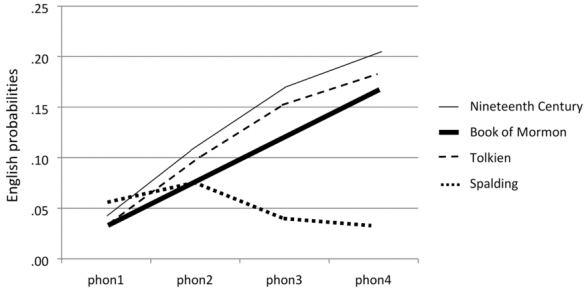
Figure 1. A comparison of the four name sources in their average English phonemic probabilities at each of the four phonemic ordinal positions.
A similar pattern was seen with bifones (see Figure 2). Because this was the case in the tests for the other hypotheses as well, only phonemes are reported in the rest of this article.
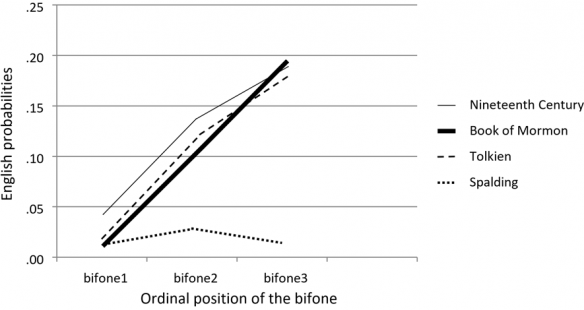
Figure 2. A comparison of the four name sources in their average English probabilities at the three bifone ordinal positions.
Second Hypothesis
The second hypothesis was extended from the first variance hypothesis but was more subtle, dealing with variances of mean phonotactic probabilities for names at various word lengths. We assumed that an author’s artificial naming system would use the same processes regardless of name length [Page 118]but that names chosen by people from varying origins and backgrounds would involve a more heterogeneous set of phonotactic structures. In other words, the phonotactic probabilities of individual phonemes in natural naming practice would vary more across name lengths.
This hypothesis was tested with a two-way multivariate analysis of variance (MANOVA) of the interactive effects of name source and name length on the ordinal position profiles of phonotactic probabilities. Figure 3 shows the phonotactic probability profiles as a function of name length for the four name sources. Nineteenth-century names and Book of Mormon names had substantially more phonotactic variation than did the names from Tolkien, particularly in the first ordinal position and in the fourth. However, the Spalding names peaked at phoneme two like the others, but the range of probabilities at phoneme positions one and four were more comparable to those seen in nineteenth-century and Book of Mormon names.
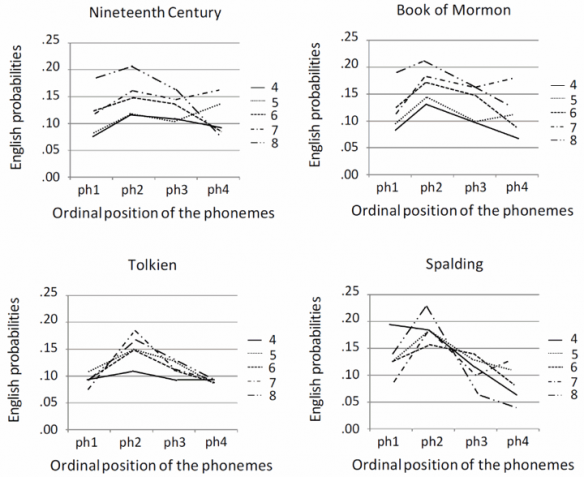
Figure 3. Phonotactic probability profiles as a function of name length for the four name sources.
Third Hypothesis
Whereas the first hypothesis explained the variances of phonotactic probabilities and the second was concerned with the variances of means within each ordinal position, the third hypothesis dealt with the patterning of the mean probabilities themselves. It held that natural and [Page 119]fictional naming systems would differ in multivariate patterns of mean phonotactic probabilities across the ordinal positions.
The results of the multivariate tests were each significant and showed differences between the Spalding names and Tolkien names, but more important for this study was that both differed significantly from the nineteenth-century names showing a clear separation between fiction and nonfiction (accounting for eight percent of the variance). Notice the wide spread at the fourth ordinal position for nineteenth- century names compared to the small spread for Tolkien and Spalding names. Notice that the Book of Mormon names show a spread similar to nineteenth- century names (see Figure 4).
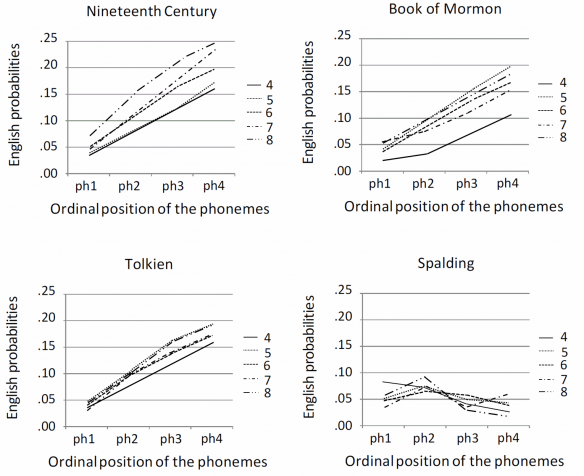
Figure 4. A comparison of the English phonemic probabilities for each word length (from four phonemes through eight phonemes) at each of the first four ordinal positions.
Fourth Hypothesis
The fourth hypothesis held that distributional properties could also distinguish between historical naming systems and individual author systems. We calculated the mean phonotactic probability for each of five name lengths (from a length of four phonemes to a length of eight) for each of the four name groups as well as the standard error of the mean (i.e., how the five length means deviate from each other) for each name source at each phoneme position.
[Page 120]Book of Mormon name variances of errors do not differ significantly from those for nineteenth-century names, but variances of errors for the Spalding and Tolkien names do differ significantly from the others. Again, this is most obvious in the fourth phoneme position (see Figure 5).
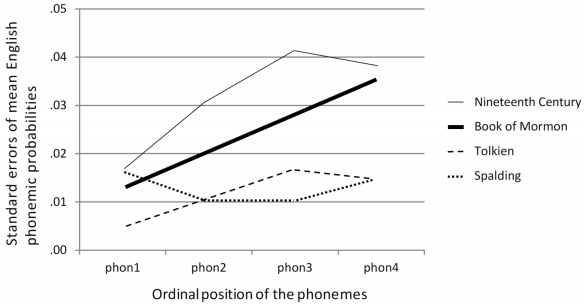
Figure 5. Standard errors of mean English phonemic probabilities as a measure of spread across the five word lengths for each of the four name sources at each of the four phoneme ordinal positions.
Summary of Findings and Discussion
In the test of the first hypothesis, Book of Mormon and Tolkien names aligned with nineteenth-century names. In the second hypothesis, Book of Mormon names and Spalding names aligned with nineteenth- century names. In the third and fourth hypotheses, Book of Mormon names aligned with nineteenth-century names and both differed significantly from Spalding and Tolkien names. In these tests, the variance of phonotactic probabilities across different name lengths was greater in the natural naming practices of nineteenth- century names than in Spalding’s and Tolkien’s fictional naming systems. Across all four tests, the Book of Mormon phonotactic probabilities were consistent with natural naming practices. Thus, the pattern that surfaced in names in the Book of Mormon seems to have more in common with the pattern found in authentic names from a century of census recording than it does with those from fictional works. We are not saying that Book of Mormon names are similar to nineteenth-century names. Rather, they both show similar patterns when phonotactic probabilities are the common measure.
[Page 121]We recognize that we have made broad diachronic comparisons between works attributed to both the nineteenth and twentieth centuries and between them and a record purportedly from ancient origins. Nevertheless, we proceeded with this study understanding that it was exploratory in nature. We wanted to determine whether there were enough phonemic differences between fictional and Book of Mormon names to merit further investigation and results seem to indicate there are.
Of course, many more invented names and words from a variety of authors and time periods will need to be analyzed before any reliable conclusions can be drawn. Similarly, many more authentic name sources across many time periods will need to be tested.
That said, results of this study indicate that when authors invent names, as Spalding and Tolkien did, they can do so with varying levels of effectiveness. They both were able to mirror the patterns found in authentic names to some extent, but seem to have been unable to replicate the patterns in authentic names that came from a variety of cultural origins. The patterns found in Book of Mormon names were consistent with those of authentic names.
Joseph Smith claimed that the Book of Mormon names are authentic from a variety of cultural origins. The fact that in this study those names have phonemic probabilities more in common with a compilation of authentic names than with fictional names may be of some interest to those who view the Book of Mormon as a translation of a historical/ religious record into English rather than as a work of fiction written in English. It appears that both authors in this study were unable to escape their phonoprints, while Book of Mormon names and nineteenth-century names did not adhere to unique phonoprints.
Bob Bennett has written, “the Book of Mormon is much more complex than its casual readers, believers and critics alike, think it is.”49 In addition, he declared, “it has all of the complexities and nuances of an authentic history.”50 When considering personal names in the text, results of this exploratory study seem to support Bennett’s statements.



Go here to see the one thought on ““Comparing Phonemic Patterns in Book of Mormon Personal Names with Fictional and Authentic Sources: An Exploratory Study”” or to comment on it.